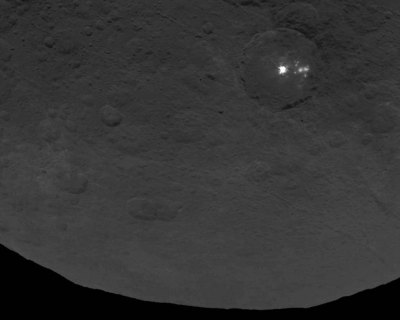In brief: More "bright spots" on Ceres

For the record, Ceres, that mysterious dwarf planet named for the Roman goddess of corn and harvests, is in the asteroid belt between Mars and Jupiter. In March, the NASA spacecraft Dawn went into orbit around Ceres, a scientific first. The robotic ship has been studying the dwarf planet from its perch 2,700 miles above Ceres.
Images of Ceres have revealed bright spots on the surface, along with a pyramid-shaped peak. The spots, probably caused by reflective material such as ice and salt, according to NASA, are in a crater about 55 miles across. New images show more of these crater spots than were previously visible.
A space agency news release explains that Dawn's equipment includes an infrared mapping spectrometer that will allow scientists to figure out what sort of minerals are on the planet's surface by studying how light is reflected.
Going to extremes: Nothing beats space as an extreme environment – but the bottom of the ocean comes close.
On July 20, an international crew will head for the bottom of the Atlantic for a 14-day mission as part of NASA's preparations for deep space exploration.
The mission’s name – NASA Extreme Environment Mission Operations 20, NEEMO – brings to mind the fictional Captain Nemo of Jules Verne’s classic, Twenty Thousand Leagues Under the Sea.
Actually, the crew won’t be quite that far under. They will be 62 feet (19 meters) below the surface at Florida International University’s Aquarius Reef Base undersea research habitat, 6.2 miles off the coast of Key Largo, Florida, according to NASA.
The mission will be led by European Space Agency astronaut Luca Parmitano, who knows something about the pitfalls of extreme environments. Parmitano, aboard the International Space Station in 2013, was in the middle of a spacewalk when his suit malfunctioned – the helmet filling with water. He made it back to the space station safely, but his vision was impaired and water entered his nose, a NASA report recounted.
During this mission, Parmitano and his crew will evaluate “tools and techniques being tested for future spacewalks on a variety of surfaces and gravity levels ranging from asteroids to the moons of Mars and the Martian surface,” a NASA press release said.
Related:
Geek alert: NASA spacecraft orbits Ceres
Water detected on dwarf planet
If you would like to comment, contact StudyHall.Rocks or like us on Facebook and tell us what you think.

